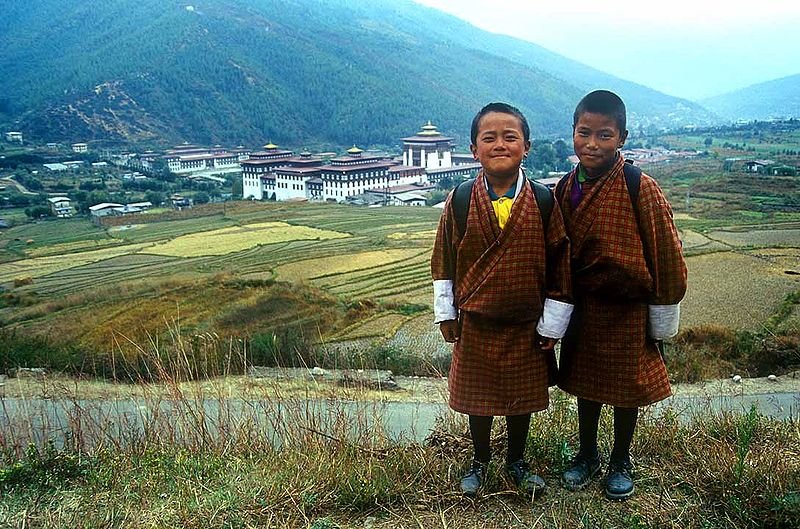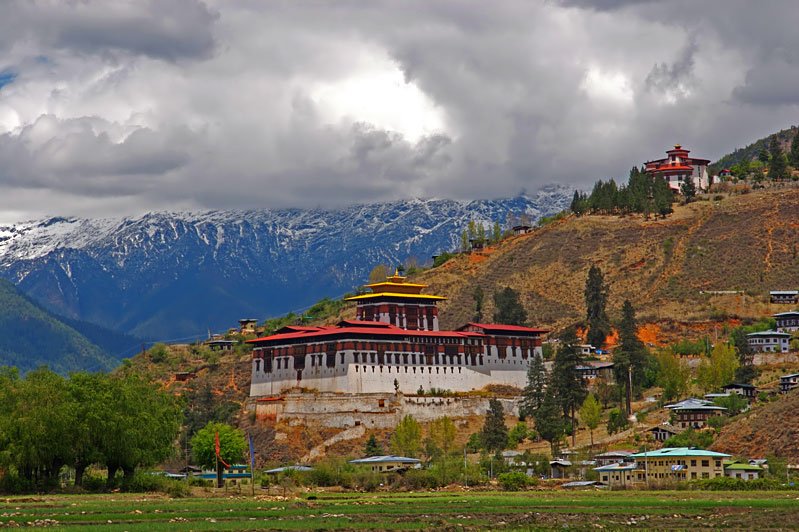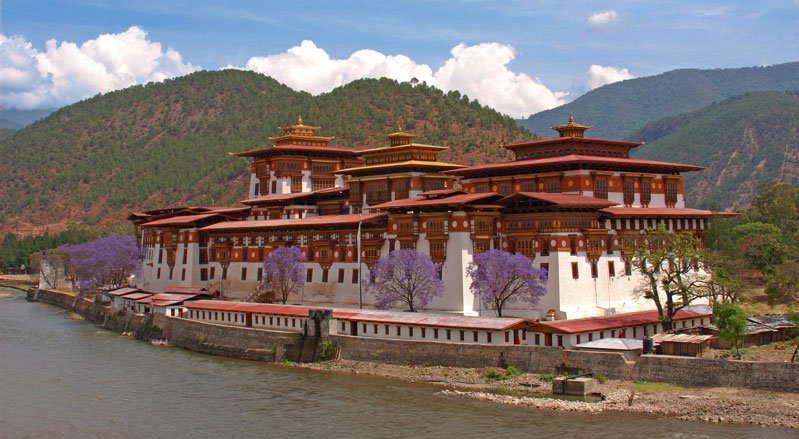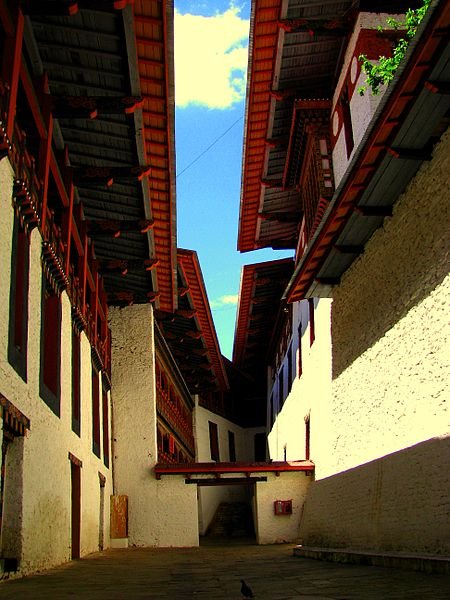 Tashichhoe Dzong, Bhutan
Tashichhoe Dzong, Bhutan http://en.wikipedia.org/wiki/File:Tashich%C3%B6dzong_Thimphu-2008-01-23.jpg
http://en.wikipedia.org/wiki/File:Tashich%C3%B6dzong_Thimphu-2008-01-23.jpg Christopher J. Fynn
Christopher J. Fynn
Bhutan is a small, landlocked kingdom in South Asia. It is bordered by India to the south, east and west, and by Tibet, China, to the north. It is separated from Nepal by the Indian state of Sikkim and from Bangladesh by the Indian state of West Bengal. Bhutan has an area of 38,394 sq km (14,824 sq miles), slightly bigger than the state of Maryland in the United States.
The capital of Bhutan is the city of Thimphu. Bhutan is a constitutional democratic monarchy headed by a king, Jigme Khesar Nemgyel Wangchuck. The head of government is prime minister Jigme Y. Thinley. The country has a population of around 700,000 (2010 estimate) and the per capita GDP stands at 1,880 (2009 estimate).
Places in Bhutan on this website
View Bhutan in a larger map
Travel Tips to Major Cities in Bhutan
- Thimphu
The capital of Bhutan since 1961. It has undergone tremendous development in the last five years. - Paro
Town in the Paro Valley of Bhutan. - Jakar
Name of small town in Bumthang District, location of the Jakar Dzong. - Punakha
Former capital and presently the administrative centre of Punakha district.
 Bhutanese children
Bhutanese children http://commons.wikimedia.org/wiki/File:Thimphu.jpg
http://commons.wikimedia.org/wiki/File:Thimphu.jpg Steve Evans
Steve Evans
The northern part of Bhutan comprises part of the Eastern Himalayan mountains, with peaks rising to over 7,000 meters. The tallest mountain in Bhutan is either the 7,553-meter (24,780-foot) Kula Kangri or the 7,570-meter (24,840-foot) Gangkhar Puensum. The uncertainty arise from the remoteness of the mountains and unconfirmed topographic studies. The southern part of Bhutan is covered with dense Himalayan subtropical broadleaf forests with mountains of around 1,500 meters (4,900 feet).
The currency of Bhutan is called the Ngultrum. It is pegged to the Indian rupee which is also accepted in the country as legal tender. Although Bhutan has one of the smallest economy in the world, it has been growing steadily, achieving a growth of 8% in 2005 and 14% in 2006. In 2007, Bhutan's economy was the second fastest growing in the world at 22.4%, contributed in part by the commissioning of the mammoth Tala Hydroelectricity project.
In 1987, in response to a comment from a journalist from UK Financial Times that Bhutan's development was too slow, the King of Bhutan responded that the Gross National Happiness is more important than the Gross National Product. Since then, many western economic psychologists have made findings questioning the level of income and its relationship to happiness. Findings from surveys discover that 45% of Bhutanese reported being very happy and 52% being happy, with only 3% reporting not being happy. The data reveals that the level of life satisfaction in Bhutan puts it within the top 10% in the world, higher than anywhere else in Asia.
 Scenery in Paro, Bhutan
Scenery in Paro, Bhutan http://commons.wikimedia.org/wiki/File:Cloud-hidden,_whereabouts_unknown_%28Paro,_Bhutan%29.jpg
http://commons.wikimedia.org/wiki/File:Cloud-hidden,_whereabouts_unknown_%28Paro,_Bhutan%29.jpg Jean-Marie Hullot
Jean-Marie Hullot
Planning your visit to Bhutan
Bhutan is not for the penniless traveler. In this instance, the term "budget" refer to the amount you are expected to spend, and that includes a luxurious budget.Everybody except the nationals of India and Bangladesh need a visa to enter Bhutan. This has to be applied at least 30 days before their date of arrival. The local travel operator has to process the visa on the traveler's behalf. Visas cannot be issued on arrival. Although the visa only costs US$20 for 14 days, it will only be issued with proof of pre-paid booking for a tour which costs from US$200 per person per night, for groups. There are surcharges for lone travelers, groups of two, and luxury hotels. Although the tours are provided by local operators, the prices are set by the Bhutan government. This is a deliberate policy to control the number of arrivals into the country.
To visit Bhutan, you will invariably need to go via India, Nepal or Thailand, so make sure you also meet the visa requirements of these countries. Nepal and Thailand offer visas on arrival as well as visa waiver for some nationalities while India requires visa to be completed before arrival, a procedure that can take two weeks.
The only international airport in Bhutan is Paro Airport, served by Druk Air, the national flag carrier. Drug Air flies to Bangkok, Kolkata, Delhi, Dhaka, Gaya, Kathmandu and Yangon. The airline will only issue you a ticket once you can provide proof of visa clearance.
Planning your travel within Bhutan
As all visitors to Bhutan are part of a tour package, your transportation will have been taken care of. Tourists are usually ferried around in minibuses and 4WD vehicles. These can be reserved through the tour operator. It is possible to hitch a ride from the locals to go from place to place: do offer to pay them for taking you on board, even though some drivers are happy just to enjoy your company. Punakha Dzong in spring
Punakha Dzong in spring http://en.wikipedia.org/wiki/File:PunakhaDzongInSpring.jpg
http://en.wikipedia.org/wiki/File:PunakhaDzongInSpring.jpg Jean-Marie Hullot
Jean-Marie Hullot
 Lane at Punakha Dzong
Lane at Punakha Dzong http://commons.wikimedia.org/wiki/File:Lanes_in_Punakha_dzong.jpg
http://commons.wikimedia.org/wiki/File:Lanes_in_Punakha_dzong.jpg Soham Banerjee
Soham Banerjee
Sights in Bhutan
Visitors come to Bhutan to admire its pristine sceneries, to view its culture, and to visit its sacred sites. The following are the places of interest in Bhutan. However, not all are open to tourists.- Jakar Dzong
Bhutanese fortress in Bumthang district. - Jambey Lhakhang
One of the 108 monasteries said to have been miraculously constructed by King Songten in one night. - Kurje Lhakhang
Sacred site in Bhutan, where Guru Rinpoche practised meditation on his first visit to Bhutan. It is the earliest Buddhist site in the country. - Lhodrak Kharchhu Lhakhang
One of the biggest monastic colleges in Bhutan. - Punakha Dzong
Bhutanese fortress constructed in Punakha by Zhabdrung Ngawang Namgyal. - Rinpung Dzong
Bhutanese fortress and Buddhist monastery in Paro district where the move Little Buddha was filmed in 1993. - Singye Dzong
This is a sacred valley which unfortunately, is not open to tourist, partly because it is near the Tibetan border. This valley contains a temple founded by Yeshi Tsogyal and visited by Guru Rinpoche on his second trip to Bhutan. - Taktsang Monastery
Located on a 1,200-meter cliff, this is the most well-known sacred site in Bhutan, with breathtaking views. The monastery was where Guru Rinpoche visited on his second trip to Bhutan. - Tamshing Lhakhang
Monastery established by Terton Padma Lingpa

Copyright © 2003-2025 Timothy Tye. All Rights Reserved.

 Go Back
Go Back